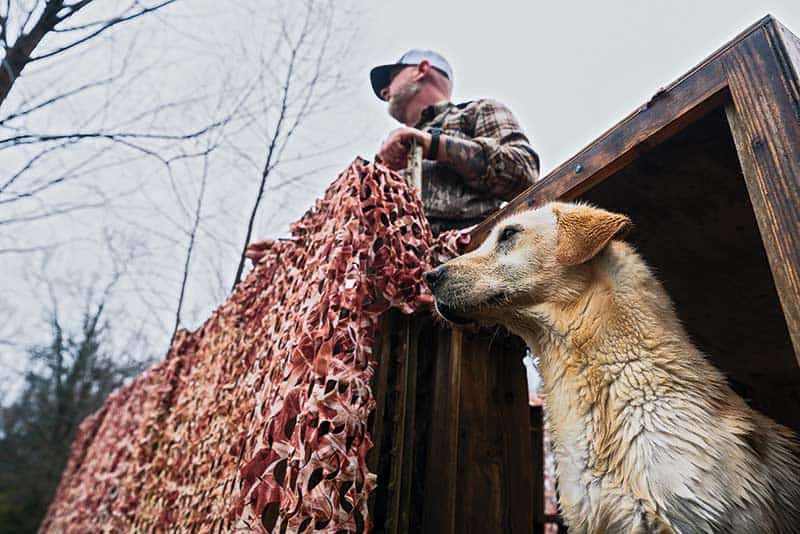“Duck Hunters, Listen up!”
The Things Waterfowl Hunting <br.Guides Wish Clients Would Do
The mallards took a quick look at the spread and kept on booking. They were high in the sky with the afterburners on. Maybe they were en route to yesterday’s buffet, or maybe they saw something they didn’t quite like.
It didn’t matter ’cause your guide hit ’em with a mix of calls. There were a few comebacks, a begging hail call and when they got closer the quacks and contented feeding chuckle sucked ’em in. In waterfowl hunting, everyone works together as a team and here are some things your guide would love you to do.
Jeremy Criscoe of Arab, Alabama’s Whistling Wings Kennels has guided waterfowl hunters in Alabama, Mississippi and Florida. The Eukanuba pro staffer says, “We’re along to help clients have a good time,” he said. “Duck hunting is what we do, and we’re in blinds, in fields, on lakes or in flooded timber every day.
“I allow clients to bring their dogs and ask only that they honestly assess their dog’s strengths and weaknesses. Tell me what your dog knows and also what he doesn’t know. I need to know if your dog is capable of marking multiple retrieves and if he can handle blind retrieves. I expect dogs to be steady and quiet when the flock is approaching just as I expect them not to bolt when a duck hits the water. There should be no jumping around in the blind and definitely no barking. It’s also important for the client/handler to listen for my command on when to send the dog out on a retrieve. If we’ve dropped three greenheads but have another group of 15 coming in, let me finish working the new flock before sending the dog on its way. The honest assessment helps make the hunt more efficient and puts more game in the bag, and I’ve got a kennel full of dogs to help if it’s necessary.”
Walt Steffens has guided hunters along the Eastern Shore of Maryland for decades.
He’s part of the Eastern Shore’s rich waterfowl legacy complete with decoy carving competitions and museums showcasing historical sinkboxes, sneak boxes and punt guns. Walt Steffens has one request: Cover up. “The most important thing a client can do to help a guide is to cover up and keep his face down. By that I mean no peeping out from behind the camo netting or looking out from the blind. This movement is without question the number one reason for spooked birds.
“What happens when light hits the hunter’s face? There is a shine visible to the birds, one that is exaggerated on a sunny day when a hunter wears sunglasses. One simple fix is to wear a camo face mask. Another is to look down at the floor. I prefer the facemask because hunters can watch the flocks’ movement and are in a better position when I call ‘take ’em.’ As a guide, my intention is to put ducks and geese in shooting range for my clients. There is nothing more frustrating than to see a committed flock flair because a client looked through an opening in the camouflage. I like to tell my hunters they can bird watch after we get some ducks on the ground, but for the first several tolls, let’s cover up, keep movement to an absolute minimum, and look at the floor.”
Lars Jacob, the owner of Vermont’s Lars Jacob Wingshooting, spends the majority of his year coaching shotgunners how to hit more targets. When it comes to guiding for waterfowl, he says the wrong amount of lead is the main reason for missed birds. “Before you come on a duck hunt, make sure you shoot targets requiring swing through, sustained lead, or pull away,” he said. “If you’ve been shooting with a Trius One Step trap throwing ground-flushed birds straight aways, then you’ll be prepared for flushing upland gamebirds. As a result, shooters probably will have a difficult time acquiring the proper lead for ducks and geese. Before a hunt, work on your passing shoots as well as your dropping targets to get the true understanding of the lead you’ll use in the duck blind.
“A second point is to study your loads, too. My hunters bring many different brands of non-toxic loads. Those shells represent a wide variety of speed, shot type and weight. Hot loads delivered by a tighter choke are great for reaching out at a distance, but if the ducks are in-close, then hunters either crush them or, more probably, miss. Talk to your guide to determine at what distance the majority of ducks will be taken. Then, pattern your shotgun with the loads and chokes you’ll use on the hunt so you’ll have the correct spread. Being prepared for the majority of your shots is key.”
Dan Wood of Connecticut Woods and Waters has been guiding waterfowlers for sea ducks, diver ducks, puddle ducks and Canada geese for over 30 years. Gun safety in the blind is his biggest request. “All hunters nod when I do my safety talk,” he said. “We duck hunt because it’s exciting, and that’s why even experienced hunters forget protocol. Nothing makes me more nervous than hearing the click coming off of a safety while I’m still working geese. Gun storage is another. Despite having built gun racks in my blinds, loaded shotguns wind up leaning against the pit’s frame. And shooting lane violations are concerns when the wind shifts and birds pour in heavy on one side.
“On some days the wind remains consistent and ducks dump only into one side. During a break in the action I’ll shift hunters around so everyone gets an opportunity. So remember the points your guide covers in his safety speech and follow the rules. There will be plenty of shooting all around and we’ll all be fine.”
These guides have spent their lives successfully working with clients. Think about their savvy advice the next time you book a trip and get ready to hunt ’em up.





